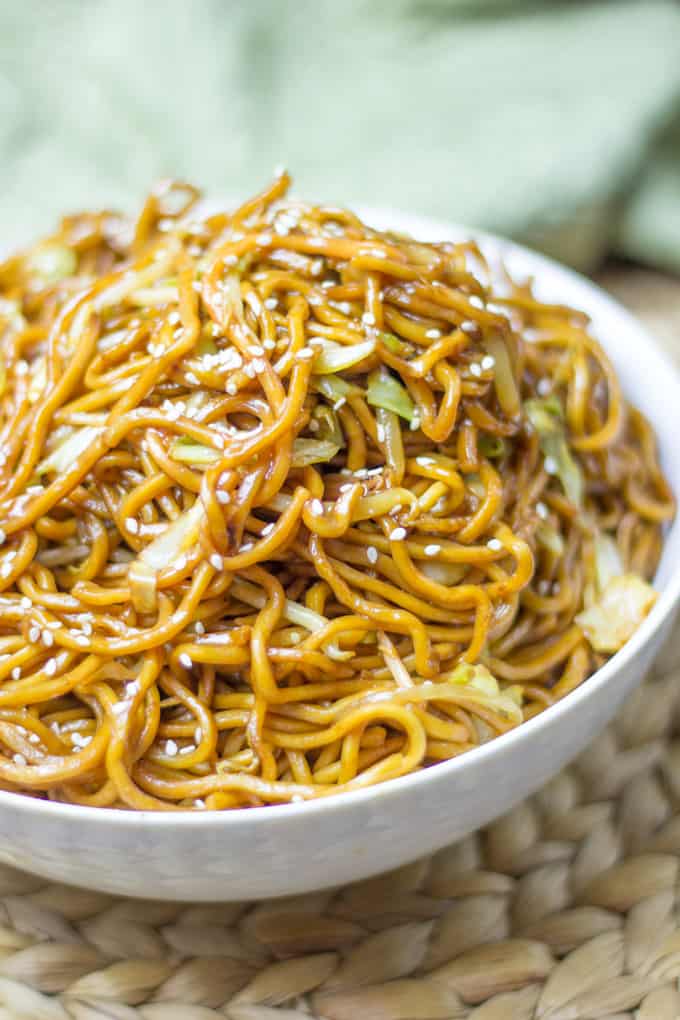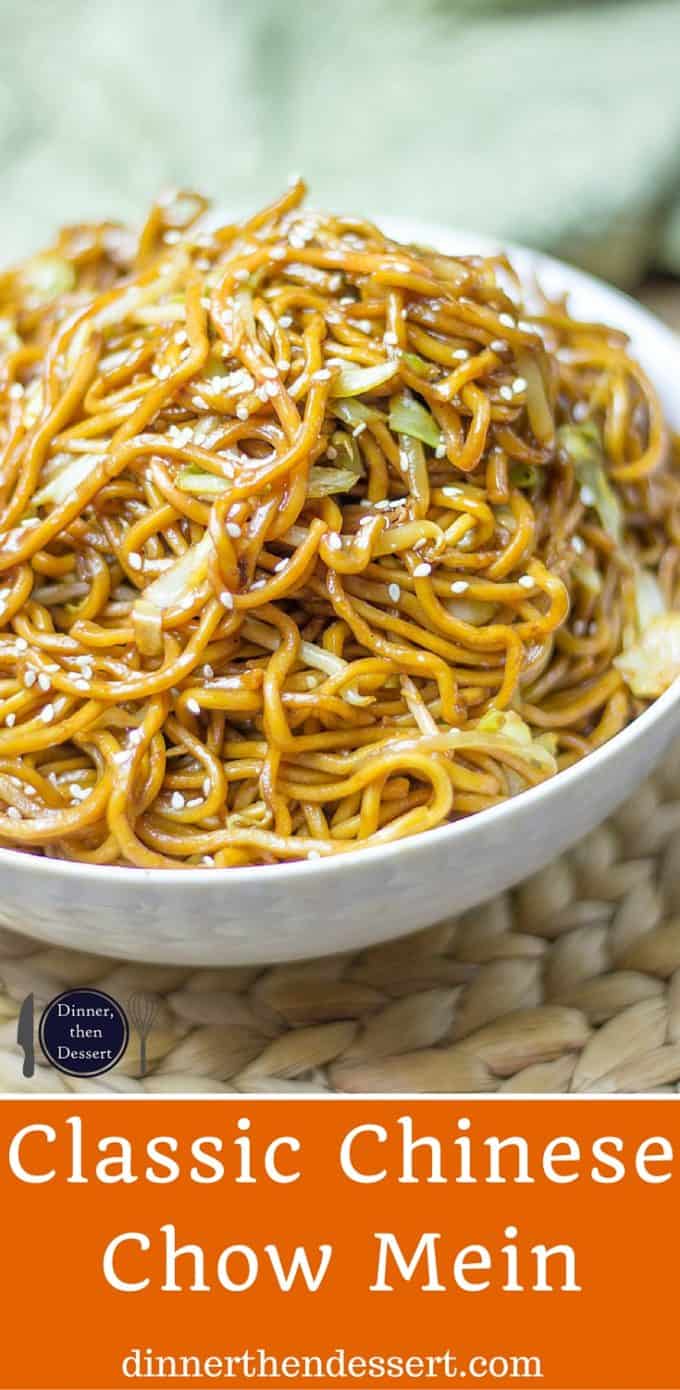Classic Chinese Chow Mein with authentic ingredients and easy ingredient swaps to make this a pantry meal in a pinch!

And you will never go back to anything less afterwards!
Some of the sauces in this Classic Chinese Chow Mein can be a bit confusing, soy sauce and dark soy sauce are definitely different things, so if you would like to learn more about it, you can look at this post from Serious Eats. If my memory serves me correct I think even my local Vons/Safeway carries all the ingredients in the recipe, but if you have a local Asian grocery store I highly suggest making a quick trip.
Also, this is after all a recipe for Classic Chinese Chow Mein, but lets talk about the ways you can customize this dish!
- Add the protein of your choice! Chicken, Shrimp, Beef, Tofu, etc.
- Spiralize some zucchini and carrots! Add the carrots with the celery and add the zucchini when you add the pasta.
- chopped peanuts or cilantro and a squeeze of lime would add a fresh dimension
- Before adding in your noodles, in a large pan add a couple of tablespoons of oil and on a high heat add the noodles until crispy on both sides for a quick pan fried noodle option!
- Add some heat! Sriracha, chili garlic paste or crushed red pepper would kick up this dish in a hurry
And then serve up your pasta with some other awesome Chinese recipes like Spicy Cashew Chicken, Orange Peel Chicken, Garlic Hunan Beef or any of the giant list of Panda Express recipes all over this blog!


Classic Chinese Chow Mein
Ingredients
- 2 tablespoons canola oil
- 1/4 head cabbage thinly sliced
- 2 cloves garlic , crushed and minced
- 2 tablespoons sweet soy sauce (aka Kecap Manis)* see note for homemade substitute
- 2 tablespoons soy sauce
- 4 tablespoons oyster sauce
- 1 cup water
- 12 ounces chow mein noodles , cooked a minute shy of the directions*
- 6 ounces bean sprouts (optional)
- sesame seeds for garnish (optional)
Instructions
- Heat a large pan or wok on high heat.
- Add two tablespoons of canola oil to the pan and cook the cabbage.
Cook 2-3 minutes until wilted, add the garlic and cook for an additional 30 seconds.
Add the soy sauce, sweet soy sauce, oyster sauce and water and bring to a boil for 1 minute.
- Add in the pasta and bean sprouts and toss to coat.
- Serve immediately
Recipe Notes
To make homemade Kecap Manis, add 1 1/2 teaspoons of soy sauce and 1 1/2 teaspoons of molasses or dark brown sugar with a tiny pinch of ground anise. This is a decent substitute, but if you can get the original the flavor will be even deeper.
If you can't find chow mein noodles you can substitute yakisoba noodles and just toss the packet and use the noodles only.
The recipe contains affiliate links.




Having read this I believed it was extremely enlightening. I appreciate you spending some time and effort to put this article together. I once again find myself spending a lot of time both reading and posting comments. But so what, it was still worthwhile!
This flavour is awesome, thanks for the recipe. I also added red onion and sliced carrot 🙂
So glad you enjoyed it!
What kind of cabbage are you using?
Green cabbage. Enjoy!
How to make it spicier ,
I love adding Sriracha for the heat. Enjoy!
I got the same soupy results as what some others mentioned. I boiled the soy sauce mixture for at least a minute and even a little longer in hopes it would start to get thick. It doesn’t have a thickening agent so I’m not sure how the soy sauce, oyster sauce and sweet soy sauce would get thick with 1 cup of water and no thickening agent. I went ahead and poured it over the noodles and it all went straight to the bottom like water or broth. I ended pouring it out and seasoned the noodles with soy sauce, salt and oyster sauce. It actually turned out pretty good after all but I wish the sauce would have thickened. Do you know what could have gone wrong? I doubled the recipe since I was using an additional package of noodles but that shouldn’t have made it soupy. Thanks for the recipe.
You need it to boil over a high heat to allow it to thicken up.
I’m trying to get the word out, but it doesn’t seem to be spreading very quickly… Except in Chinese restaurants. THIS RECIPE IS NOT FOR CHOW MEIN. THIS IS LO MEIN. Chow mein is a vegetable dish. Lo mein is what you have pictured here and is a noodle dish.
They call it chow mein at Panda Express and this recipe is similar to her copycat Panda Express Chow Mein recipe. But go ahead and correct her Karen.
That’s because Panda Express is far from authentic.
Linda a quick google came up with the definition of Chow Mein which means “fried noodles”, Lo Mein means “Tossed Noodles” sooooo I believe the vegetable dish you are referring to to is Chop Suey not Chow Mein which is a fried noodle dish. Anyway Karen
On the west coast, chow mein is this kind, and the term lo mein is not commonly used. The fried kind is usually just called Hong Kong style. The terminology just differs depending on which region you’re from.
Linda, when I saw this, I thought the same thing. I was expecting the 70s style one in white sauce.
First of all Linda I don’t even know why you clicked on her recipe because it obviously says Copycat recipe for Panda Express Chow Mein! (PANDA EXPRESS)!!!
So don’t be ganging up on Sabrina about this is not chow mein. You can take your attitude to Panda Express and tell them that it’s actually lo mein not chow mein. Kay hun. Thank you!
Linda Stiles (Karen) look up what the difference between chow mein and lo mein and let me know what the difference is. Thank you!
in regards to the substitution for sweet soy sauce. The recipe calls for 2T. of sweet soy sauce but the substitution is only equal to 1T…should this be doubled?
Yes
Hi! I want to try this recipe out? How can it be stored? Can I make it and put some in the freezer?
You can store in the fridge up to 3 days and in the freezer up to 3 months. Store in an airtight container and allow to cool completely before freezing. Hope this helps 🙂
Best method to reheat?
Personally I like to reheat in the wok, tossing for a few minutes. You can also reheat in the microwave.
I made this with Lo mien noodles. They were very sticky. But over all I feel as if it was a very salty dish.
I’m sorry to hear that it didn’t come out to your taste. If you try it again, I would reduce the oyster and regular soy sauce to cut the saltiness and use Chow Mein noodles to keep it from getting sticky. Hope this helps!
Try using low-sodium soy sauce.
HI, LOOKING FOR A WHITE PLASTIC BOTTLE WITH BLUE AND WHITE LABLE. IT ONLY SAYS CHOWMEIN SEASONING ON LABEL.
Looks so good I planned to prepare because I love chow mai
Enjoy!
Hi! Where do I find chow mien noodles? Are they different from lo mien noodles? Are lo mien noodles an ok substitute if I can’t find chow mien? Thank you!
Lo Mein noodles are a bit thicker. My recommendation would be to get the Yakisoba packages and use the noodles in that if you’re having a hard time finding them. They work as a great substitue. Enjoy!